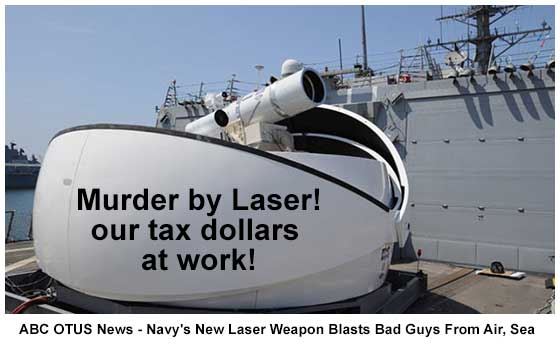U.S. Navy's New Laser Weapon Blasts Good or Bad Guys From Air, Sea - Murder by Laser, our tax dollars at work

- By LUIS MARTINEZ - ABC OTUS News – April 9, 2013
No longer the fantasy weapon of tomorrow, the U.S. Navy is set to field a powerful laser that can protect its ships by blasting targets with high-intensity light beams.
Early next year the Navy will place a laser weapon aboard a ship in the Persian Gulf where it could be used to fend off approaching unmanned aerial vehicles or speedboats.
The Navy calls its futuristic weapon LAWS, which stands for the Laser Weapon System. What looks like a small telescope is actually a weapon that can track a moving target and fire a steady laser beam strong enough to burn a hole through steel.
A Navy video of testing conducted last summer off the coast of California shows how a laser beam fired from a Navy destroyer was able to set aflame an approaching UAV or drone, sending it crashing into the ocean.
"There was not a single miss" during the testing, said Rear Admiral Matthew Klunder, chief of Naval Research. The laser was three for three in bringing down an approaching unmanned aerial vehicle and 12 for 12 when previous tests are factored in.
But don't expect in that video to see the firing of colored laser bursts that Hollywood has used for its futuristic laser guns. The Navy's laser ray is not visible to the naked eye because it is in the infrared spectrum.
Many of the details about how the laser works remain secret, such as how far its beam can travel, how powerful it is or how much power is used to generate it.
But Navy officials have provided a few unclassified details. For example, the laser is designed to be a "plug and play" system that integrates into a ship's existing targeting technologies and power grids. Those factors make it a surprisingly cheap weapon.
Klunder says each pulse of energy from the laser "costs under a dollar" and it can be used against weapons systems that are significantly more expensive. The Navy says it has spent about $40 million over the past six years in developing the weapon.
Rear Admiral Thomas Eccles, Navy Sea Systems Command, says the beam can be turned on instantly and that ultimately "the generation of power is essentially your magazine. It's the clip we have" instead of bullets. "We deliver precision with essentially an endless supply of rounds."
Some new technological fixes, what Klunder calls "a secret sauce," have been developed to improve the degrading of lasers over distance as well as maintaining a lock on a target from a moving ship.
The strength of the beam is flexible enough that at a lower intensity level it can be used to warn approaching ships and UAV's not to get too close to a Navy ship. Instead of using machine guns to fire non-lethal warning shots as Navy ships do now, the laser can be aimed to "dazzle" the viewing sensors aboard the craft. That light effect warns the pilot of a small water craft or at the controls of a UAV that they are being targeted by a laser and to turn away. If they don't, the laser's power can be boosted to destroy the approaching craft.
Based on earlier testing the Navy is confident the laser is ready for real-world testing aboard the USS Ponce in the Persian Gulf. The ship was selected because of its mission to be an enduring presence in the Gulf to counter Iranian maritime threats in the region. Coincidentally Iran uses small fast boats to harass American warships in the waters of the Persian Gulf.
How might Iran feel about the new weapon? "Frankly I hope it sends a message to some of our potentially threatening adversaries out there to know that we mean business," said Klunder. "This is a system where if you try to harm our vessels that I hope you will take a very, very serious moment of pause to think about that before you do it because this system will destroy your vessel or will destroy your UAV."
The Navy wants the ship's crew to use the same techniques and methods they use with their other defensive weapons systems.
While for now the laser will be used primarily against slow-moving UAV's and fast boats cruising at speeds of 50 knots, the Navy sees the system's capabilities expanding over time to target faster weapons.
"There's absolutely every intention that with the development of this system and follow-on upgraded systems we will eventually be able to take higher speeds in-bound," said Klunder.


